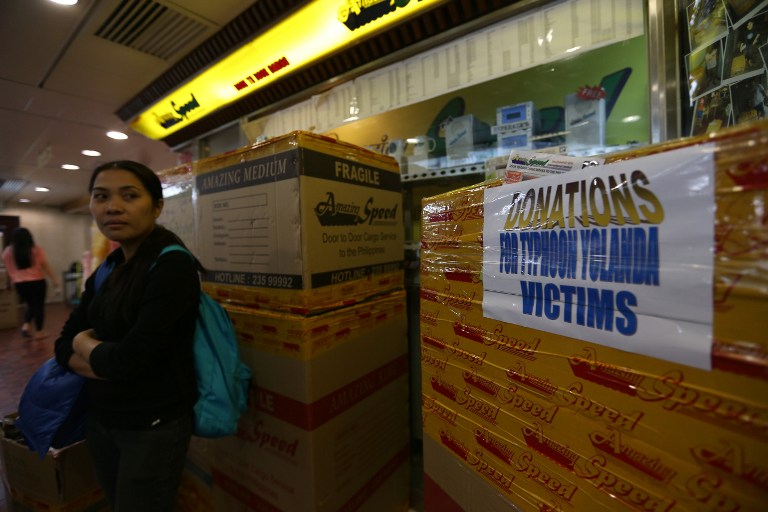
A woman looks on while standing next to a donation box for victims of Supertyphoon “Yolanda” (Haiyan) in Hong Kong on Wednesday, Nov. 13, 2013. With thousands feared dead and aid only trickling in after the supertyphoon laid waste to entire coastal towns on Nov. 8, many among the 10-million-strong disaspora are still frantically trying to find out if their relatives are alive and their homes still standing. In Hong Kong, where some 150,000 Filipinos work as domestic helpers, the Red Cross said a hotline set up to trace the missing had been overwhelmed since the typhoon smashed into the nation’s central islands, displacing an estimated 673,000. AFP PHOTO/AARON TAM
HONG KONG—Filipinos abroad, who have spent harrowing days trying to contact loved ones after a typhoon devastated their homeland, are mobilizing to send relief, despite misgivings about corrupt local officials pocketing aid on the ground.
With thousands feared dead and aid only trickling in after Supertyphoon “Yolanda” (international name: “Haiyan”) laid waste to entire coastal towns on Friday, many among the 10-million-strong diaspora are still frantically trying to find out if their relatives are alive and their homes still standing.
And from Asian capitals to the United States and Europe, Filipino communities are taking to churches and social media sites to raise funds for communities left with nothing—and growing increasingly desperate.
In Hong Kong, where some 150,000 Filipinos work as domestic helpers, the Red Cross said a hotline set up to trace the missing had been overwhelmed since the typhoon smashed into the nation’s central islands, displacing an estimated 673,000.
“The maids were crying. They didn’t know what to do,” spokesperson Denise Wong told AFP.
Liezel Miralles, a 40-year-old domestic worker from Batad, a coastal town of 20,000 people, had not been able to contact her husband and other relatives to find out if they had survived.
“I feel very, very, very sad, my whole family is there,” Miralles said as she bought groceries for her employer at a street-side market. “There is no house, no phone, no connection.”
On Sunday, when Hong Kong’s downtown throngs with domestic helpers congregating on their day-off, worker groups will hold an “information drive” on the crisis and gather donations.
But support group United Filipinos is one of many organizations and individuals around the world planning to direct aid only to nongovernment agencies.
“We are afraid that if we send to the government, it will just to go their pockets and will not reach the beneficiaries,” secretary general Eman Villanueva told AFP.
“Politicians are using it for their own benefit even in the midst of this devastating situation. They are still thinking for themselves.”
In Singapore, Dimples Larrazabal said the 24 hours it took for her to get in touch with her mother, her brother and his family in the town of Ormoc in devastated Leyte province seemed like an eternity.
“At first I was half-positive (that things would be OK) because our house is a good structure,” said Larrazabal, a 35-year-old homemaker. But she began to panic after seeing photos showing the unimaginable devastation.
“That’s when I cried ‘Oh my God! Nothing was spared!” she said. “I knew that Ormoc was directly in the path of the typhoon.”
Social media sites were inundated with posts from people searching for missing relatives, uploading pictures of individuals and families on Facebook and Twitter in posts tagged #tracingPH or simply #missing.
Google said it had updated its Person Finder site—which helps people find loved ones after a disaster—to include Philippines’ mobile numbers.
Krima Molina, a 26-year-old teacher from storm-struck Leyte now living in Tokyo, said she watched in horror as Facebook posts from friends at home turned into increasingly desperate pleas for help.
Homeless survivors were becoming ill from exposure, left with no shelter but makeshift shanties made of plastic tarps draped over plywood, she said. “They need medicine. They need volunteer doctors. A lot of people are injured.”
Many of the homes destroyed have been built with the earnings of the staggering 10 percent of the population that works abroad.

